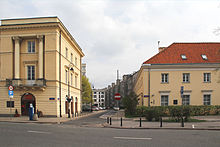Galeria Luxenburga
The Galeria Luxenburga (also Pasaż Luxenburga ) was one of the first and the largest shopping center in Warsaw before World War II . It was built at the beginning of the 20th century and was destroyed in the course of the fighting in 1944. In place of the former Galeria, which was located in the inner city district at Ulica Senatorska 29 , today the Ulica Bernarda Belotta Canaletta runs .
history
The building complex was built between 1907 and 1909 according to a design by the architects Czesław Przybylski (1880–1936) and Leon S. Drews. The client - and partly responsible for the design - was the Jewish entrepreneur Maxymilian Luxenburg, whose name the center also bore. The complex consisted of two brick, side rows of buildings; the intermediate hall was covered by a blue tinted glass roof. The facades of the buildings as well as the interior were a mixture of modern classicism and empire . The Latin inscription at the entrance read: "Suis et Sibi - MCMIX" (1909). The buildings were equipped with the most modern equipment at the time: central heating, electrical lighting, ventilation systems and elevators.
The front of the western wing facing Senatorska was the front facade of the “Grand Hotel” integrated into the complex. The interior of the hotel was in the style of Polish secession (Art Nouveau) and local folk art ( Sztuka ludowa ). The architect Józef Gałęzowski (1877–1963) and the art professor Edward Trojanowski (1873–1930) were responsible for the interior design. Another integrated cinema was operated under different names: "Splendid", later "Momus". It was rebuilt in the interwar period ; Ancient Egyptian decorations were created in the interior and a suitable name was found: "Sfinks". The cinema had 2000 seats and was 18 meters high with its two balconies. From 1919 to 1931 the shopping center also housed the “ Qui-Pro-Quo ” theater , where stars such as Hanka Ordonówna and Mira Zimińska performed. From 1933 to 1937 it was replaced by a "Jung Teater" designated Jewish experimental theater ( Żydowskie Studio Eksperymentalne Teatr Młodych ).
In the more than 700 rooms of the complex there were next to the hotel, the theater and the shops, several cafes, restaurants as well as an ice rink in the basement and the largest billiard room in Warsaw. Shortly before the beginning of the war in 1914, Abraham Eisenberg set up a Jewish art salon in the gallery. The Galeria had its heyday before the First World War ; in the 1930s the operator ran into financial difficulties. During the bitter fighting in this part of the city during the Warsaw Uprising , the building burned down almost completely in the late summer of 1944; the manager of the complex at the time was Maurycy Luxenburg, a nephew of the builder. The last ruins were demolished in the 1950s and replaced by ul. Bernarda Belotta Canaletta , which runs here today .
References and comments
- ↑ a b Małgorzata Omilanowska, Świątynie handlu: warszawska architektura komercyjna doby wielkomiejskiej , ISBN 9788389101327 , publisher: Instytut Sztuki Polskiej Akademii Nauk, Warsaw 2004, p. 232 (in Polish, accessed on April 28, 2013)
- ↑ Maxymilian Luxe n burg is not to be confused with Maxymilian Luxe m burg (owner of the trading house Luxemburg i spółka ), who lives in Warsaw at the same time, has almost the same name , according to Jerzy S. Majewski, Senatorska 29. Galeria Luxenburga była największym krytym pasażem Warszawy bele epoque at Gazeta.pl (Warszawa) on September 18, 2003 (in Polish, accessed on April 28, 2013)
- ↑ This “Grand Hotel” is not to be confused with the newer, still existing Grand Hotel in ul. Krucza
- ↑ Natasza Styrna, Artyści żydowscy w Krakowie 1873-1939: katalog wystawy , Muzeum Historyczne Miasta Krakowa (publisher and ed.), Krakau 2008, p. 21
- ^ Tadeusz Władysław Świątek, Rody starej Warszawy , Verlag: Bis-Press, 2000, p. 109 (in Polish, accessed on April 29, 2013)
literature
- Jerzy S. Majewski, Warszawa na starych pocztówkach , ISBN 978-83-268-1238-5 , from the series: Biblioteka Gazety Wyborczej , Agora SA, Warsaw 2013, p. 114
Web links
- Historical photo of the interior of the "Splendid" cinema (accessed on April 28, 2013)
- Senatorska 29 - Galeria Luxenburga near Warszawa której już nie ma from December 28, 2010, with historical photos (in Polish, accessed April 28, 2013)
- Galeria Luksenburga at Warszawa1939.pl, with various historical photos (in Polish, accessed on April 28, 2013)
Coordinates: 52 ° 14 ′ 36.1 ″ N , 21 ° 0 ′ 24.9 ″ E
